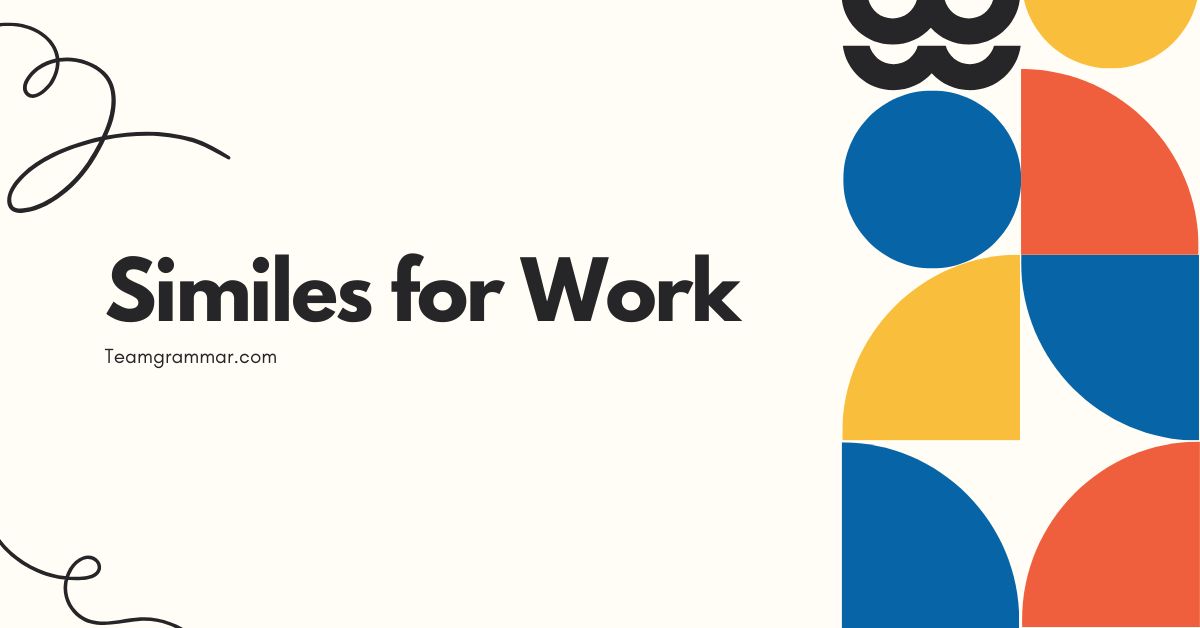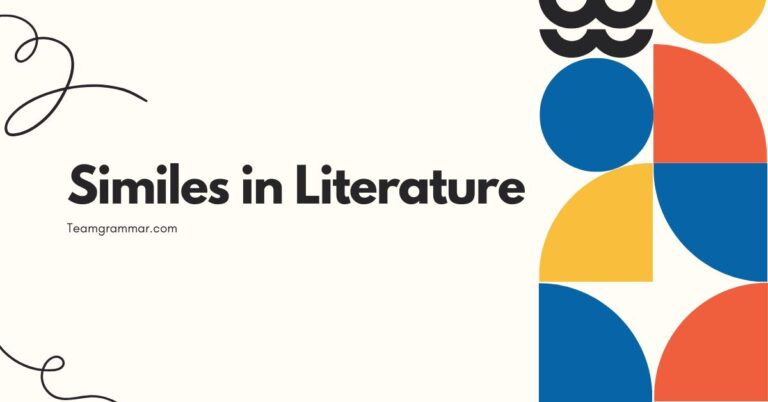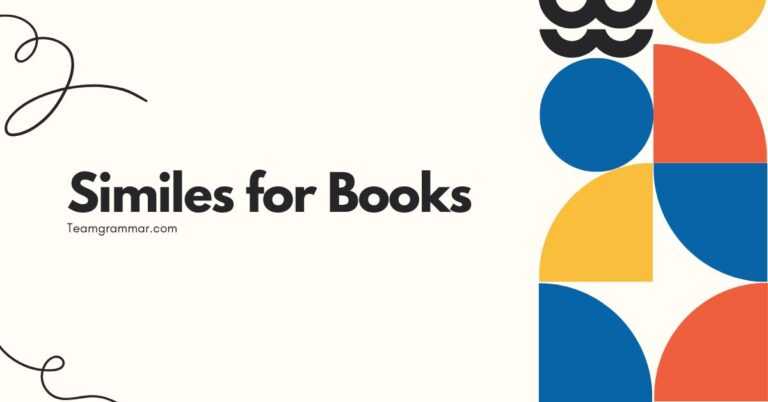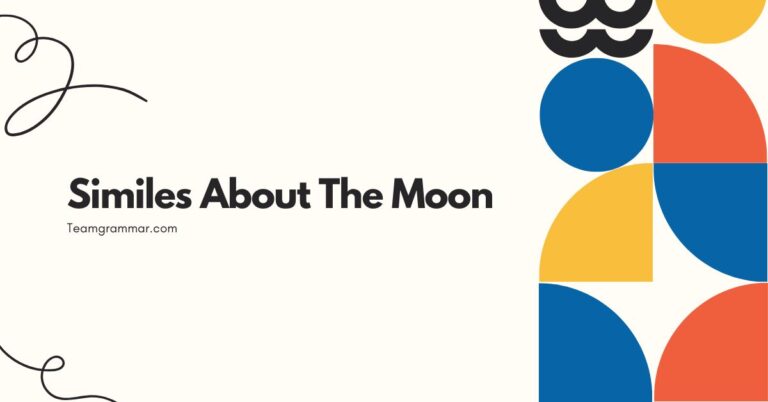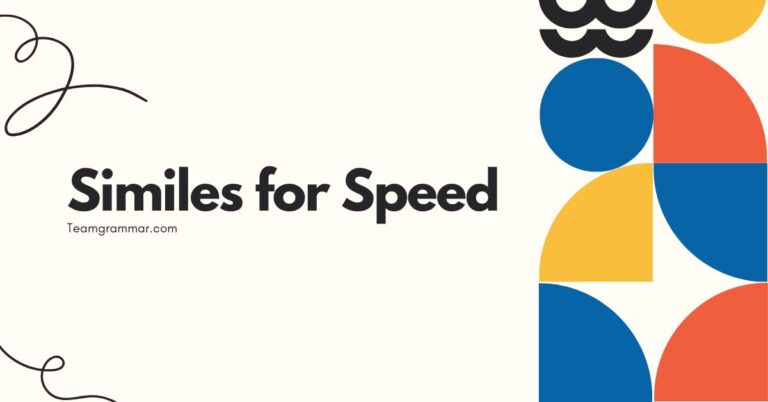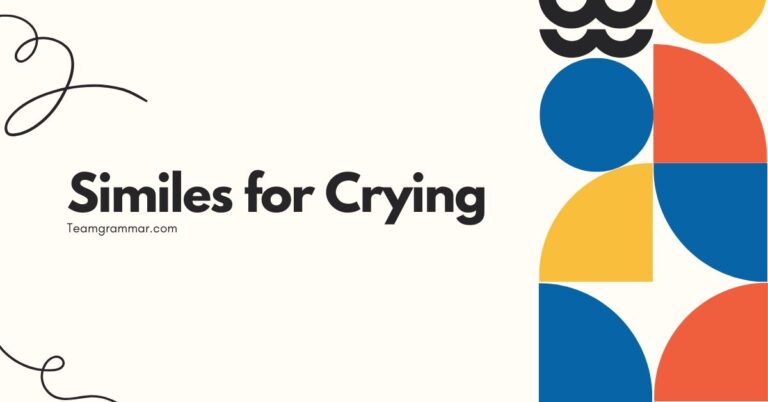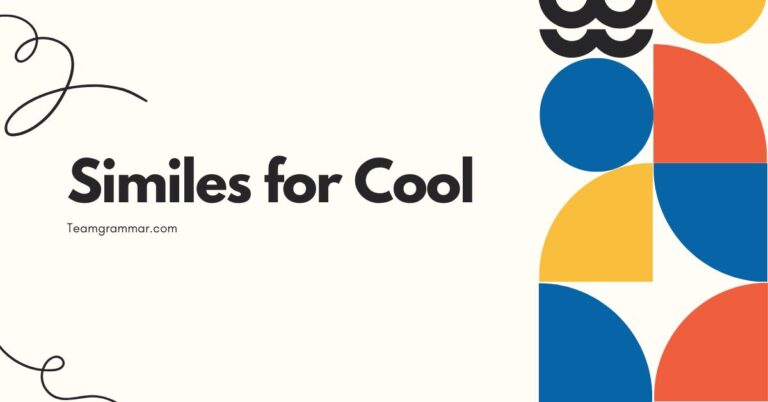26 Similes for Work: Enhancing Workplace Communication
Similes are powerful tools that can add color, clarity, and impact to workplace communication. Understanding and using similes effectively can make your writing and speaking more engaging, helping you connect with colleagues, clients, and superiors.
This article provides a comprehensive guide to similes for work, covering their definition, structure, types, usage rules, common mistakes, and practice exercises. Whether you’re a seasoned professional or just starting your career, mastering similes will enhance your ability to communicate persuasively and creatively in any professional setting.
Table of Contents
- Introduction
- Definition of Similes
- Structural Breakdown of Similes
- Types of Similes
- Examples of Similes for Work
- Usage Rules for Similes
- Common Mistakes with Similes
- Practice Exercises
- Advanced Topics in Similes
- Frequently Asked Questions
- Conclusion
Definition of Similes
A simile is a figure of speech that compares two unlike things using the words “like” or “as.” Its primary function is to enhance understanding and create vivid imagery by drawing a parallel between something familiar and something less known. Similes can make complex ideas more accessible, add emotional depth to your writing, and make your communication more engaging and memorable.
In the workplace, similes are used to clarify ideas, emphasize points, and add creativity to presentations, reports, and everyday conversations. They can transform mundane messages into compelling narratives, improving overall communication effectiveness.
The classification of similes falls under the broader category of figurative language, which also includes metaphors, analogies, and personification. Unlike metaphors, which directly equate two things, similes maintain a comparison using “like” or “as.” This distinction allows for a more nuanced and less assertive comparison.
Similes are particularly useful when you want to highlight a specific similarity between two things without implying complete equivalence. For example, saying “He works like a machine” suggests a high level of efficiency, while “He is a machine” (a metaphor) implies he lacks emotion or humanity.
Understanding this difference is crucial for effective communication.
Structural Breakdown of Similes
The basic structure of a simile consists of three main components: thesubjectbeing described, thelinking word(“like” or “as”), and theobject of comparison.The subject is the entity or concept you are trying to explain or illustrate. The linking word establishes the comparison, indicating that the subject shares a characteristic with the object of comparison.
The object of comparison is something that is generally well-understood and serves to illuminate the subject. Understanding this structure is essential for constructing clear and effective similes.
Let’s break down the structure with examples. In the simile “Her presentation was as clear as crystal,” “her presentation” is the subject, “as” is the linking word, and “crystal” is the object of comparison.
This structure highlights the clarity of the presentation by comparing it to the well-known transparency of crystal. Similarly, in the simile “His dedication is like a burning flame,” “his dedication” is the subject, “like” is the linking word, and “a burning flame” is the object of comparison.
This illustrates the intensity and passion of his dedication.
The effectiveness of a simile depends on the relevance and clarity of the comparison. The object of comparison should be something that the audience can easily understand and relate to.
A well-chosen comparison can create a strong mental image and make your message more memorable. For example, if you’re describing a complex software system, you might say, “Navigating this software is like finding your way through a maze.” This simile uses a familiar experience (navigating a maze) to help the audience understand the difficulty of using the software.
Types of Similes
Similes can be categorized based on the type of comparison they make and the effect they create. Here are some common types of similes:
Descriptive Similes
Descriptive similes focus on physical attributes or qualities. They paint a vivid picture by comparing the subject to something with similar characteristics.
For example, “The office was as quiet as a library” describes the atmosphere of the office. These similes are often used to create a specific mood or tone.
Action Similes
Action similes compare the way something moves or behaves. They often use verbs to emphasize the similarity in action.
For example, “He works like a beaver” describes someone who is diligent and hardworking. These similes can add energy and dynamism to your writing.
Emotional Similes
Emotional similes relate to feelings or states of mind. They help to convey emotional depth and connect with the audience on an emotional level.
For example, “She felt as light as a feather after getting the promotion” describes her sense of relief and joy.
Exaggerated Similes
Exaggerated similes, also known as hyperbole, use extreme comparisons to emphasize a point. While they are not meant to be taken literally, they can be very effective in making a strong impression.
For example, “This project is as big as the ocean” exaggerates the scope of the project.
Understated Similes
Understated similes use subtle comparisons to create a sense of irony or humor. They can be effective in softening criticism or making a point in a gentle way.
For example, “His negotiation skills are as sharp as a butter knife” is an understated way of saying that his negotiation skills are not very effective.
Examples of Similes for Work
Here are several examples of similes categorized by common workplace scenarios. These examples are designed to illustrate how similes can be used to enhance communication in various professional contexts.
Each table provides diverse examples to help you understand the range and versatility of similes.
Similes for Describing Performance
This table illustrates similes used to describe job performance, both positive and negative.
| Simile | Meaning |
|---|---|
| He performs like a well-oiled machine. | He is very efficient and effective. |
| She works as hard as a beaver. | She is very diligent and industrious. |
| His progress is as slow as molasses. | He is making very little progress. |
| She’s as quick as a whip. | She is very fast and responsive. |
| He’s as steady as a rock. | He is reliable and dependable. |
| Her ideas flow like a river. | She has a constant stream of innovative ideas. |
| He’s as sharp as a tack. | He is very intelligent and perceptive. |
| She’s as busy as a bee. | She is extremely active and engaged. |
| His attention to detail is like a hawk’s eye. | He is very observant and precise. |
| She delivers results as consistently as the sunrise. | Her performance is highly reliable and predictable. |
| His work ethic is like a tireless engine. | He is incredibly hardworking and persistent. |
| She handles pressure like a seasoned athlete. | She remains calm and effective under stress. |
| He approaches challenges as eagerly as a child opening a gift. | He is enthusiastic and motivated to overcome obstacles. |
| Her problem-solving skills are as refined as a master craftsman’s. | She is highly skilled and effective at solving problems. |
| He’s as organized as a librarian. | He is very systematic and structured in his work. |
| She’s as adaptable as a chameleon. | She can easily adjust to changing circumstances and new environments. |
| His productivity is like a factory in full swing. | He is producing a large amount of work efficiently. |
| She communicates as clearly as a bell. | She is very articulate and easy to understand. |
| He learns new skills as quickly as a sponge absorbs water. | He is a fast learner and easily retains information. |
| Her leadership is as inspiring as a motivational speaker’s. | She motivates and encourages her team effectively. |
| He manages his time like a Swiss watch. | He is extremely punctual and precise with his schedule. |
| She’s as resilient as a rubber ball. | She quickly recovers from setbacks and remains positive. |
| His dedication is like a beacon in the night. | He is a guiding light and source of inspiration for his colleagues. |
| He tackles problems like a detective solving a case. | He is methodical and thorough in his approach to problem-solving. |
| She navigates office politics as smoothly as a seasoned diplomat. | She is skilled at handling delicate situations and maintaining positive relationships. |
| His presentations are as engaging as a captivating movie. | He captures and holds the audience’s attention effectively. |
| She’s as collaborative as a team of musicians playing in harmony. | She works well with others and contributes to a cohesive team environment. |
| His creativity is like a boundless canvas. | He has a limitless imagination and generates innovative ideas. |
| She’s as persistent as a marathon runner. | She is determined and unwavering in her pursuit of goals. |
| His decision-making is as decisive as a chess grandmaster’s. | He makes confident and strategic choices. |
Similes for Describing Workplace Environment
This table provides similes that describe the atmosphere and conditions of a workplace.
| Simile | Meaning |
|---|---|
| The office is as quiet as a tomb. | The office is very silent and still. |
| The atmosphere is as tense as a drum. | There is a lot of stress and anxiety. |
| The workload is like climbing Mount Everest. | The amount of work is overwhelming and challenging. |
| The collaboration is as seamless as a symphony. | The teamwork is very smooth and harmonious. |
| The morale is as low as the ground. | The overall mood and enthusiasm are very poor. |
| The office is as chaotic as a zoo. | The office is disorganized and full of activity. |
| The environment is as competitive as the Olympics. | There is a strong sense of rivalry and competition. |
| The communication flows as freely as a river. | Information is shared openly and easily. |
| The pressure is like a weight on my shoulders. | The stress and responsibilities feel heavy and burdensome. |
| The office politics are as tangled as a spider web. | The relationships and power dynamics are complex and confusing. |
| The energy in the room is as electric as a live wire. | The atmosphere is vibrant and exciting. |
| The new policies are as clear as mud. | The new policies are confusing and difficult to understand. |
| The team’s spirit is as strong as an oak. | The team is resilient and united. |
| The training program is as comprehensive as an encyclopedia. | The training is thorough and covers all aspects. |
| The company culture is as welcoming as an open door. | The culture is inclusive and friendly. |
| The bureaucracy is as thick as pea soup. | There is a lot of red tape and paperwork. |
| The opportunities here are as vast as the horizon. | There are many possibilities and career paths available. |
| The resources are as scarce as water in the desert. | There is a lack of necessary materials and support. |
| The leadership is as inspiring as a guiding star. | The leaders motivate and direct the team effectively. |
| The atmosphere after the deadline was as relaxed as a vacation. | The mood was calm and stress-free. |
| The pace of work is as relentless as a ticking clock. | The work is constant and demanding. |
| The support system is as reliable as a sturdy bridge. | The support is dependable and strong. |
| The office design is as modern as a spaceship. | The office is sleek and innovative in its layout. |
| The learning curve is as steep as a mountain climb. | Mastering new skills requires significant effort and time. |
| The competition among employees is as fierce as a jungle. | The rivalry is intense and aggressive. |
| The company’s growth is as rapid as a bamboo shoot. | The company is expanding quickly and steadily. |
| The work environment is as stimulating as a brainstorming session. | The workplace is creative and encourages new ideas. |
| The teamwork is as synchronized as a dance routine. | The team members work together seamlessly and harmoniously. |
| The challenges we face are as unpredictable as the weather. | The difficulties are unexpected and constantly changing. |
| The feedback is as constructive as a building plan. | The advice is helpful and guides improvement effectively. |
Similes for Describing Communication
This table presents similes used to describe different aspects of communication in the workplace.
| Simile | Meaning |
|---|---|
| His explanation was as clear as day. | His explanation was very easy to understand. |
| Her instructions were as precise as a laser beam. | Her instructions were very specific and accurate. |
| The feedback was as sharp as a knife. | The feedback was critical and direct. |
| His tone was as cold as ice. | His tone was unfriendly and distant. |
| Her email was as long as a novel. | Her email was very lengthy and detailed. |
| His presentation was as dry as toast. | His presentation was boring and unengaging. |
| Her voice was as smooth as silk. | Her voice was pleasant and soothing. |
| His argument was as strong as steel. | His argument was persuasive and well-supported. |
| Her response was as quick as lightning. | Her response was very fast and immediate. |
| His speech was as rambling as a country road. | His speech was disorganized and went off on tangents. |
| Her message was as clear as a bell. | Her message was easily understood and straightforward. |
| His communication style is as direct as an arrow. | He is forthright and avoids ambiguity. |
| Her words were as comforting as a warm blanket. | Her words provided reassurance and support. |
| His explanation was as convoluted as a maze. | His explanation was confusing and difficult to follow. |
| Her feedback was as gentle as a feather. | Her feedback was kind and considerate. |
| His questions were as probing as a surgeon’s scalpel. | His questions were thorough and insightful. |
| Her report was as comprehensive as a textbook. | Her report covered all aspects of the topic in detail. |
| His presentation was as persuasive as a seasoned lawyer’s argument. | His presentation was convincing and compelling. |
| Her writing style is as elegant as classical music. | Her writing is refined and sophisticated. |
| His jokes were as stale as old bread. | His jokes were unfunny and predictable. |
| Her tone was as enthusiastic as a cheerleader’s. | Her tone was energetic and encouraging. |
| His explanations are as accessible as a children’s book. | His explanations are easy to understand for everyone. |
| Her emails are as concise as a tweet. | Her emails are brief and to the point. |
| His interview was as intense as a grilling. | The interview was rigorous and demanding. |
| Her response was as diplomatic as a politician’s. | Her response was tactful and carefully worded. |
| His presentation was as captivating as a theatrical performance. | His presentation was engaging and held the audience’s attention. |
| Her negotiation skills are as sharp as a razor. | She is highly skilled and effective in negotiations. |
| His communication style is as transparent as glass. | He is open and honest in his communication. |
| Her speech was as inspiring as a motivational speaker’s. | Her speech motivated and encouraged the audience. |
| His summary was as brief as a headline. | His summary was very short and concise. |
Usage Rules for Similes
Using similes effectively requires understanding and adhering to certain rules. These guidelines ensure that your similes are clear, relevant, and impactful.
A poorly constructed simile can be confusing or even humorous in the wrong way, so it’s important to pay attention to these rules.
- Ensure Relevance: The comparison should be logical and relevant to the subject. The object of comparison should share a clear characteristic with the subject.
- Avoid Clichés: Overused similes, such as “as busy as a bee” or “as strong as an ox,” can sound unoriginal and lack impact. Try to come up with fresh and creative comparisons.
- Maintain Clarity: The comparison should be easy to understand. Avoid using obscure or overly complex objects of comparison.
- Use Appropriately: Similes are most effective when used sparingly. Overusing them can make your writing sound forced and unnatural.
- Consider Your Audience: Choose comparisons that your audience will understand and relate to. A simile that works well for one audience may not be effective for another.
For example, instead of saying “He was as busy as a bee,” which is a cliché, you could say “He was as busy as a project manager juggling multiple deadlines.” This simile is more specific and relevant to the workplace. Similarly, instead of saying “The meeting was as boring as watching paint dry,” you could say “The meeting was as tedious as reading a lengthy legal document.” This provides a more vivid and relatable comparison.
Common Mistakes with Similes
Even experienced writers and speakers can make mistakes when using similes. Being aware of these common errors can help you avoid them and ensure that your similes are effective and accurate.
Here are some frequent mistakes and how to correct them:
| Incorrect | Correct | Explanation |
|---|---|---|
| He is like a building. | He is as strong as a building. | The comparison is incomplete; specify the quality being compared. |
| She works as a dog. | She works like a dog. | Use “like” instead of “as” when comparing actions. |
| The project was as big than an elephant. | The project was as big as an elephant. | Use “as” in both parts of the comparison. |
| His presentation was like a boring lecture. | His presentation was as boring as a lecture. | The comparison is redundant; avoid comparing something to itself. |
| The deadline was as close. | The deadline was as close as tomorrow. | The comparison is vague; specify what the deadline is being compared to. |
| He runs as fast like a cheetah. | He runs as fast as a cheetah. | Avoid using both “as” and “like” in the same simile. |
| She is intelligent as an owl. | She is as intelligent as an owl. | Ensure correct word order for clarity. |
| His ideas were like a confusing puzzle. | His ideas were as confusing as a puzzle. | Use “as” when comparing a characteristic. |
Practice Exercises
Test your understanding of similes with these practice exercises. Each exercise includes a set of questions with answers provided below.
These exercises are designed to help you identify and correct common mistakes, as well as practice creating your own similes.
Exercise 1: Identifying Similes
Identify the simile in each sentence.
| Question | Answer |
|---|---|
| 1. Her presentation was as clear as crystal. | as clear as crystal |
| 2. He works like a machine. | like a machine |
| 3. The project is a mountain to climb. | (No simile – this is a metaphor) |
| 4. She is as quick as a whip. | as quick as a whip |
| 5. The office was as quiet as a library. | as quiet as a library |
| 6. He shouted like a madman. | like a madman |
| 7. The agreement was as solid as a rock. | as solid as a rock |
| 8. She navigated the crisis like a seasoned captain. | like a seasoned captain |
| 9. The task was herculean. | (No simile – this is an adjective) |
| 10. He is as wise as an owl. | as wise as an owl |
Exercise 2: Completing Similes
Complete the following similes with appropriate endings.
| Question | Answer |
|---|---|
| 1. The deadline is as close as __________. | tomorrow |
| 2. He is as strong as __________. | an ox |
| 3. She works like __________. | a beaver |
| 4. The office is as quiet as __________. | a tomb |
| 5. The project is as big as __________. | the ocean |
| 6. His explanation was as clear as __________. | day |
| 7. The atmosphere was as tense as __________. | a drum |
| 8. She delivered the presentation like __________. | a pro |
| 9. The team worked together like __________. | a well-oiled machine |
| 10. His ideas flowed as freely as __________. | a river |
Exercise 3: Correcting Similes
Correct the following incorrect similes.
| Question | Answer |
|---|---|
| 1. He is like a building. | He is as strong as a building. |
| 2. She works as a dog. | She works like a dog. |
| 3. The project was as big than an elephant. | The project was as big as an elephant. |
| 4. His presentation was like a boring lecture. | His presentation was as boring as a lecture. |
| 5. The deadline was as close. | The deadline was as close as tomorrow. |
| 6. He runs as fast like a cheetah. | He runs as fast as a cheetah. |
| 7. She is intelligent as an owl. | She is as intelligent as an owl. |
| 8. His ideas were like a confusing puzzle. | His ideas were as confusing as a puzzle. |
| 9. The manager was as angry than a bear. | The manager was as angry as a bear. |
| 10. The office is quiet as a mouse. | The office is as quiet as a mouse. |
Advanced Topics in Similes
For advanced learners, understanding the nuances and subtleties of similes can significantly enhance their writing and communication skills. This section delves into more complex aspects of similes, including extended similes, metaphorical similes, and the use of similes in persuasive writing.
These advanced techniques can add depth, creativity, and impact to your communication.
Extended Similes
An extended simile is a simile that is developed over several lines or sentences. Instead of a brief comparison, an extended simile explores the similarities between the subject and the object of comparison in greater detail.
This technique allows you to create a more vivid and memorable image in the reader’s mind. For example, instead of simply saying “The project was like a marathon,” you could say, “The project was like a marathon, requiring endurance, careful pacing, and a strong finish.
Each stage presented its own challenges, demanding perseverance and strategic planning, just like the miles of a marathon.”
Metaphorical Similes
A metaphorical simile combines the characteristics of both similes and metaphors. While it uses “like” or “as” to make a comparison, the comparison itself is often more abstract and symbolic.
This can add layers of meaning to your writing and create a more profound connection with the audience. For example, “His leadership was like a lighthouse, guiding the team through stormy seas” uses the lighthouse as a metaphor for guidance and safety, while still maintaining the simile structure.
Similes in Persuasive Writing
Similes can be powerful tools in persuasive writing. By comparing your argument or proposal to something familiar and positive, you can make it more appealing and convincing to your audience.
For example, “Investing in this project is like planting a seed that will grow into a mighty tree, providing shade and sustenance for years to come” uses a simile to convey the long-term benefits and value of the investment.
Frequently Asked Questions
Here are some frequently asked questions about similes, along with detailed answers to help clarify any remaining doubts.
- What is the difference between a simile and a metaphor?
A simile compares two unlike things using “like” or “as,” while a metaphor directly equates them without using these words. A simile says something is like something else, whereas a metaphor says something is something else. For example, “He is like a lion” (simile) versus “He is a lion” (metaphor).
- Why are similes used in writing?
Similes are used to enhance understanding, create vivid imagery, add emotional depth, and make writing more engaging and memorable. They help to clarify complex ideas and connect with the audience on a deeper level.
- How do you create a good simile?
To create a good simile, ensure the comparison is relevant, avoid clichés, maintain clarity, use similes appropriately, and consider your audience. Choose comparisons that are logical, fresh, easy to understand, and appropriate for the context.
- What are some common mistakes to avoid when using similes?
Common mistakes include using incomplete comparisons, using “as” instead of “like” (or vice versa) incorrectly, using redundant comparisons, making vague comparisons, and using both “as” and “like” in the same simile.
- Can similes be overused?
Yes, similes can be overused. Overusing them can make your writing sound forced, unnatural, and repetitive. It’s best to use similes sparingly and only when they add significant value to your communication.
- How do you identify a simile in a sentence?
A simile can be identified by the presence of the words “like” or “as,” which are used to make a comparison between two unlike things. Look for these words and identify the two things being compared.
- What is an extended simile?
An extended simile is a simile that is developed over several lines or sentences, exploring the similarities between the subject and the object of comparison in greater detail. This technique creates a more vivid and memorable image.
- How can similes be used in persuasive writing?
Similes can make your argument or proposal more appealing and convincing by comparing it to something familiar and positive. This helps the audience understand the benefits and value of your proposal.
- Are similes appropriate for professional communication?
Yes, when used correctly, similes can be highly effective in professional communication. They can add clarity, creativity, and impact to your writing and speaking, helping you connect with colleagues, clients, and superiors.
- How do I avoid using clichés when creating similes?
To avoid clichés, think creatively and try to come up with original comparisons. Instead of using overused phrases, consider specific details and unique characteristics that can create a fresh and engaging image.
Conclusion
Mastering the use of similes can significantly enhance your communication skills in the workplace. By understanding their definition, structure, types, usage rules, and common mistakes, you can craft more engaging, clear, and impactful messages.
Similes add color and depth to your writing and speaking, making complex ideas more accessible and fostering stronger connections with your audience. Remember to practice using similes regularly and be mindful of avoiding clichés and ensuring relevance in your comparisons.
By incorporating similes thoughtfully and creatively into your professional communication, you can elevate your presentations, reports, and everyday conversations. The ability to draw meaningful comparisons not only clarifies your message but also showcases your creativity and attention to detail.
Continue to explore and experiment with similes to refine your skills and make a lasting impression in your professional interactions. Embrace the power of similes to transform your communication from ordinary to extraordinary, and watch as your ideas resonate more profoundly with your colleagues and clients.

